This article is about climbing Mount Japfu – the second-highest peak of Nagaland.
I have shared my journey of how I planned and experienced snow for the first time in my life.
Nagaland and I have share a bond for adventure.
It was the trek to Mount Saramati – the highest peak of Nagaland which instilled in me a love for trekking and adventure.
Treks in Nagaland are best for both beginners and hardcore trekkers.
For the detailed Mount Japfu Peak Trek Guide, please refer to the FAQ Section.
Mount Japfu Peak Trek
About Mount Japfu
Mt. Japfu is located in the Jakhama circle of Kohima District in the northeastern state of Nagaland.
Also known as Japfü or Japvo, it is considerewd as the 2nd highest peak of the state.
The popular trail to reach Japfu Peak starts from Kigwema which is at a distance of 16.3 km from Kohima town.

A friendship built through Instagram, Kezha after having read my travelogue on Dzukou Valley insisted on visiting Nagaland again.
Having summitted Mt. Saramati (3826m) in 2016, Mt. Japfu (3048m) had always been on my list.
I unknowingly had its glimpse when we halted at Kigwema during our Mt. Saramati Expedition, to realize only now that it is Mt. Japfu, haha!
Towards the end of December and early January of 2020, Nagaland received a considerable amount of snowfall. Elated, we decided to go for the trek on January 19th.
Day 1 – Adventurous entry to Kohima
Kicking off the day by passing the Driving Test at the District Transport Office (D.T.O) of Dibrugarh, Assam, the train journey began conversing with random travellers about their lives.
Sunrise at Brahmaputra (Dibrugarh) and Sunset at Dhansiri (Dimapur, Nagaland) the play of the sun with colours on both occasions was something I had missed due to my late morning routine.
The fact that the train was running 1.5 hours late, my chance to catch a cab from Dimapur for Kohima was fading.
I reached Dimapur around 5:30 p.m. narrowly managing to board the last sumo.
When the driver said, “Nahi hoga aur ek jan” (no seat for another person), all my hope was gutted.
Luckily, a cab driver who had just arrived from Kohima agreed to take us (five other passengers) back to Kohima again.
We are grateful to him for saving us from the dilemma.
As we drove up and neared Kohima, the hills glowed like a Christmas tree decorated with twinkling lights.
Deboarding near Oking Hospital around 10 p.m., it was a relief to have finally reached Morung Lodge Homestay. The conversation with the caretaker during dinner was interesting.
I was surprised that he knew the prominent Anthropologist Late Verrier Elwin. As Kohima’s tranquilness slumbered for the night, I followed the same.
Day 2 – Solo Kohima Tour & Japfu Peak Trek
Exploring the Kohima Tourist Places
Waking up at 5:58 am, I unravelled the curtains; the sun greeted me through the window with its golden glow.
Starring at the distant hills, and chirping of birds, I sat on an armchair writing and describing this very beauty.
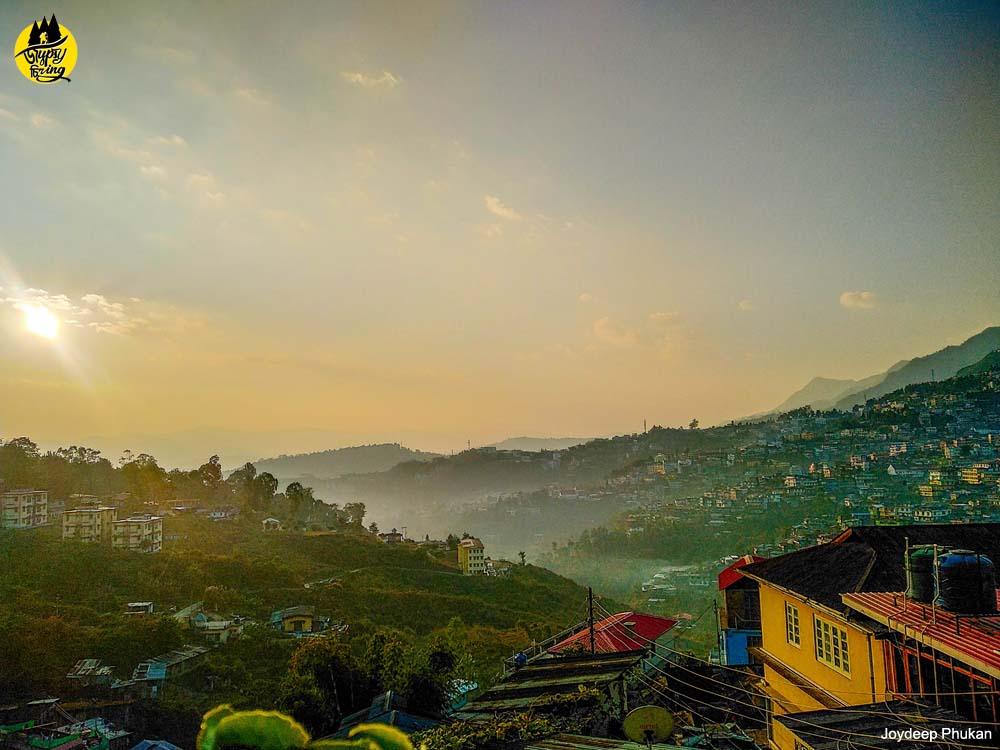
Like the Darjeeling Days, I set out for a walk around the town.
To recreate my last visit to the Central Guest House, I took a stroll through the narrow street down the bus stand. It was all the same except the shops were closed.
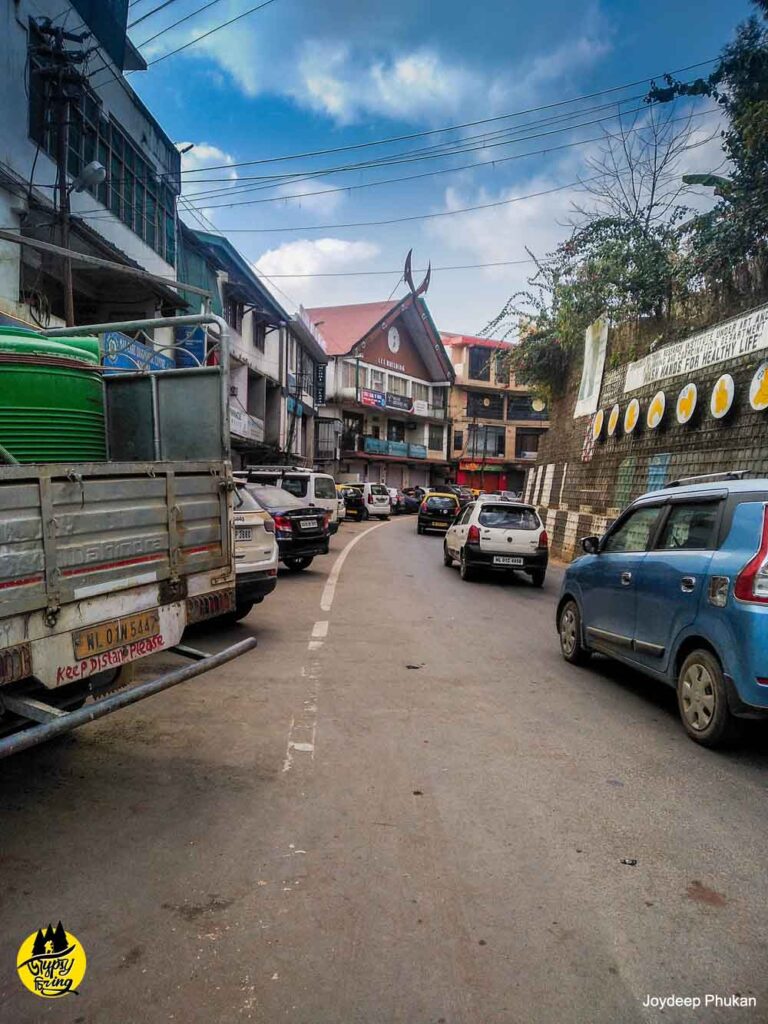
Eagerly searching for a viewpoint of the hills of outer Kohima, I eventually got one towards the New Market Area down the road.
Opposite the Central Guest House, the path via the churches leads to a beautiful view of the city.
Fairly a busy street, folks dressed up in flamboyant traditional and formal had gathered for Mass in the churches.
Meanwhile, a cat laid out on a wooden post rested on the tin wood house-cottage structure.
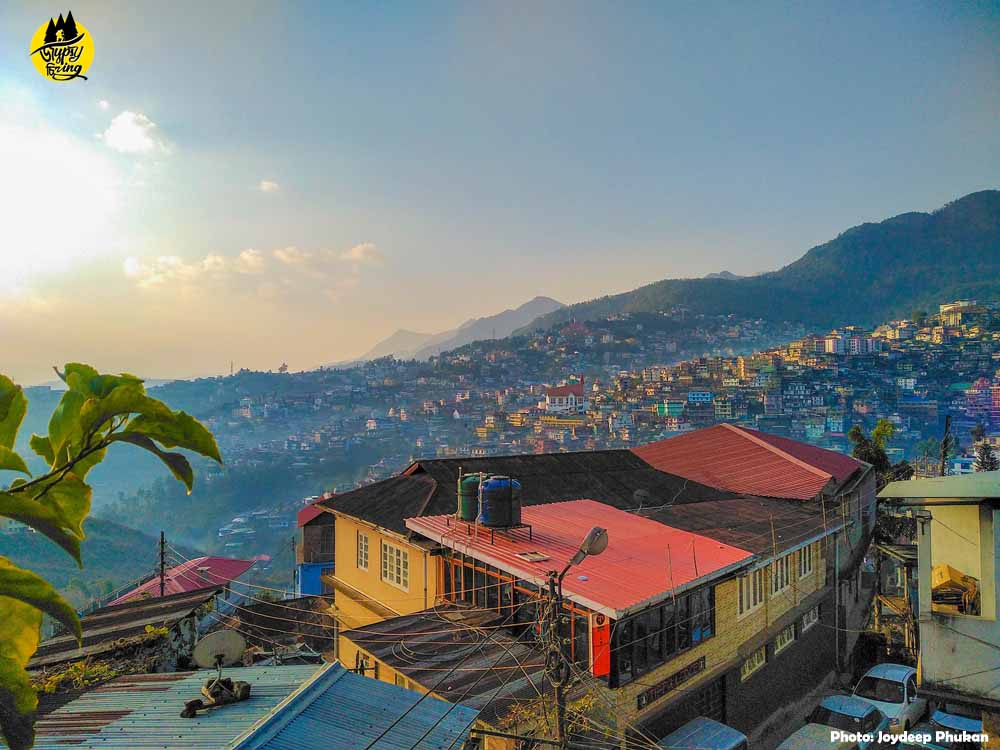
Back at Morung Lodge, listening to the gospel nearby, I spoke to the founder of Explore Nagaland– Nino Zhasa, for the first time properly.
She shared her anecdotes of visiting Thanamir- the apple village and Saramati which is the highest peak of Nagaland.
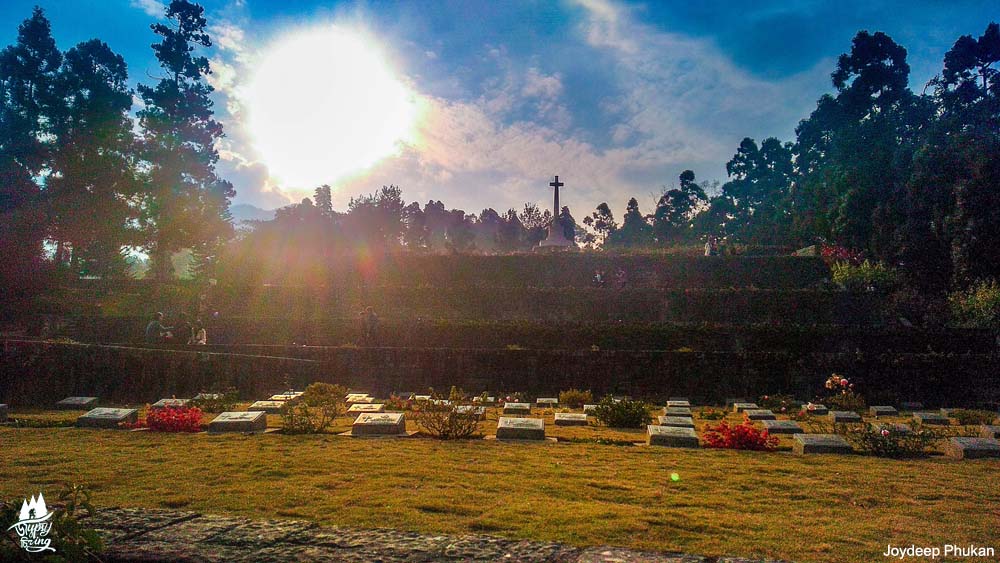
At the Nagaland War Cemetery, the students gathered with uniforms and cultural dresses- it was possibly their Educational tour.
A few did cycle stunts and clicked photos, some danced, a few explained the history of the place to their friends; while I wondered about my presence.
I was possibly there for two reasons- the place had a historical significance.
Secondly, I just wanted to be by myself connecting to the moments like the sun shining on the burial structures signifying the sacrifice of the soldiers and the essence of the place.
There was a little cute kid merrily jumping and singing around while his mom ran behind to protect him from falling – both enjoying the little moments of pure happiness.
On one hand, were the bliss, fun, and beauty and on the other hand, lay the sufferings and the victory of defeating the Japanese in the Battle of Kohima,1944.

The cemetery stood with a panoramic view of Kohima town filled with green hills and rich architectural church buildings.
The red uniformed students were excited to click their group photos adding liveliness to the entire landscape.
With Kezha’s arrival at the lodge, I rushed back. Unaware of the proceedings of the trip until now; meeting him for the first time, we spoke about Mt. Japfu and Hornbill Festival.
All the other hikers (18) assembled at his friend’s house in Chandmari, a suburb of Kohima.
An Uncle, in his seventies, narrated his experience of climbing Japfu in 1955.
He also shared about the time of Indian Independence; the armed conflict that terrified people from going out of their homes.
The Night Trek to Japfu Peak Base Camp
Reaching Kigwema by sunset, the night trek to the Base Camp of Mt. Japfu began around 5:30 pm. Through the Japfu Christian College road, we marched ahead.
This motorable road ended at a horse stable (locally known as a Pony farm). My pace slowed down as the trail got steeper from the potato farm.
The higher we hiked the more beautiful the views were.
At every stop, we turned off our lights and would lay down gazing at the winter sky – the crescent reddish moon, the stars, and the hills under it.
Kehu -the traditional cheering melody sung by fellow Naga trekkers kept us pumped up all the time.
The shrill high-pitched war cry called Mepfü which usually accompanies the Kehu chants at intervals resonated with the hills of Mt. Japfu.
The best thing about hiking with them was their authentic approach to walking in the woods. The cheer worked on me.
I chanted along with them as we heard our friends collecting firewood near the Base Camp of Japfu Peak.
Base Camp Scene
Amidst the forest trees, there stood a wooden “Chang Ghar” – the base camp of Mt. Japfu.
It was getting colder; I rushed to the kitchen and embraced the warmth of the fire.
Unloading our backpacks, we jumped, sang and cheered in the hall area of the base-camp.
The most endearing moments were the conversations with everyone about culture, travel and life.
The view of the clear skies above the tranquil forest from the base camp soothed the mind. A nap from 11:30 p.m. to 1 a.m. gave me the required rest.
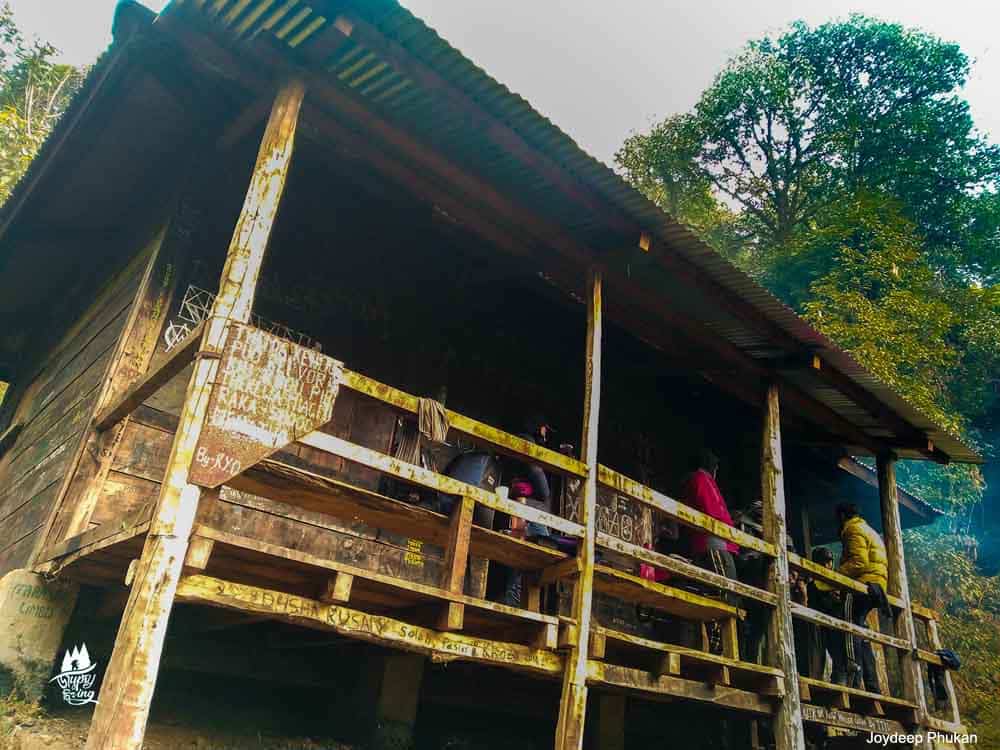
Base Camp to Japfu Peak – the Biting Cold Wind & Trail dead-end
The last to start from the base camp, my eyes searched for my teammates who merged into the darkness of the woods. The wind grew stronger and colder.
As I had been slower till the camp, henceforth I sped up by being consistent.
The cityscapes faded while the more alluring night landscapes halloed us as we climbed higher. The chilly cold wind compelled us to keep moving and make fewer stops.
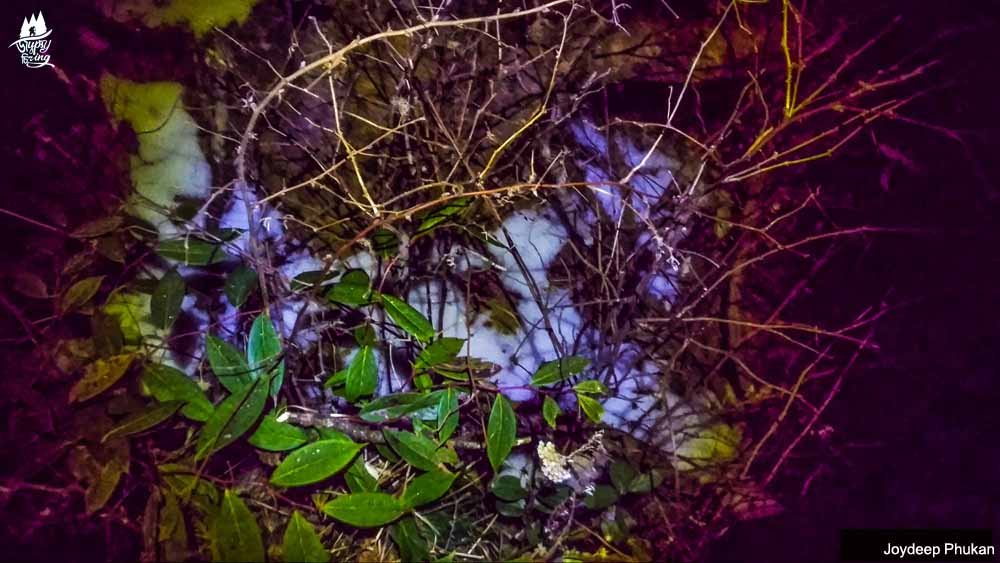
Seeing ice midway – I was the happiest. Our bottles were empty; I chose to eat a piece of unmelted snow. Ah! Silly but full of contentment.
The ice patches started appearing more. We climbed two small rock walls. The trail ahead turned slippery due to frost.
A fellow trekker beside me kept asking if this was the right trail. Kezha and a few others were already ahead, we could only hear their voice.
We kept going, but then appeared a dead-end; a rock wall with no trails stood right at the front. At this point, Kezha had already reached the peak.
The fingers under the gloves went numb. I had to warm them up once in a while.
Adding to that, the strongest of the wind blowing with no mercy pierced through my body every few seconds as if I were a droplet of water; the wind was a fraction of light resulting in the formation of a rainbow.
Baffled and angry I screamed at Kezha from below, unaware that it was even colder at the top.
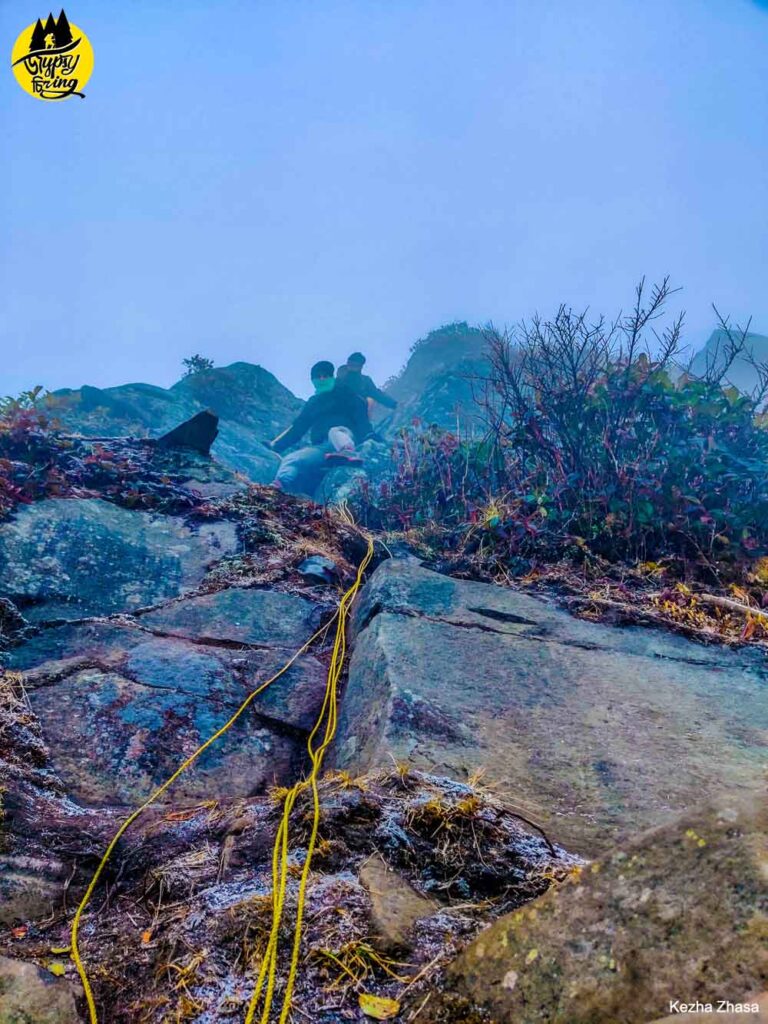
Thanks to him, he even descended a few steps of the rock wall and boosted our morale.
While I waited at the dead end, Kezha’s cousin also named Kezha, traversed the wall laterally and found the way.
This motivated me a lot. I was searching for this trail, but the only thing I saw was the slippery wall with mosses.
The triumph of summiting the Japfu peak can be interpreted as that rainbow.
A total of 10 of us reached the summit. Grips did exist in the final rock wall, but holding on to it, pulling up the body, and finding the right grips with numb fingers at night was challenging. The happiest I was as I overcame it.
The scenes at the peak were different. The wind with its strongest valour blew at an interval of 5-10 seconds.
The howling winds forced everyone to take shelter under a tiny cave with little space. Reaching the peak around 4:30 am, we waited until light prevailed over dawn.
But the peak was surrounded by dense fog. I still cherish those funny conversations on weather forecasting and how desperately hopeful we were for the golden sunrise.
Day 3 – The Japfu Peak Snow Surprise
Explored the peak in dense fog
While the rest had descended, Kezha, his cousin and I stayed at the peak and explored a bit more. Honestly, I assumed the cave to be the peak. The peak is huge.
The cross above the cave passage denotes the top of Japfu. Further ahead lies the trail that leads to the western part of Dzukou Valley.
Mt. Saramati and the Eastern Himalayas can be seen from the peak too.
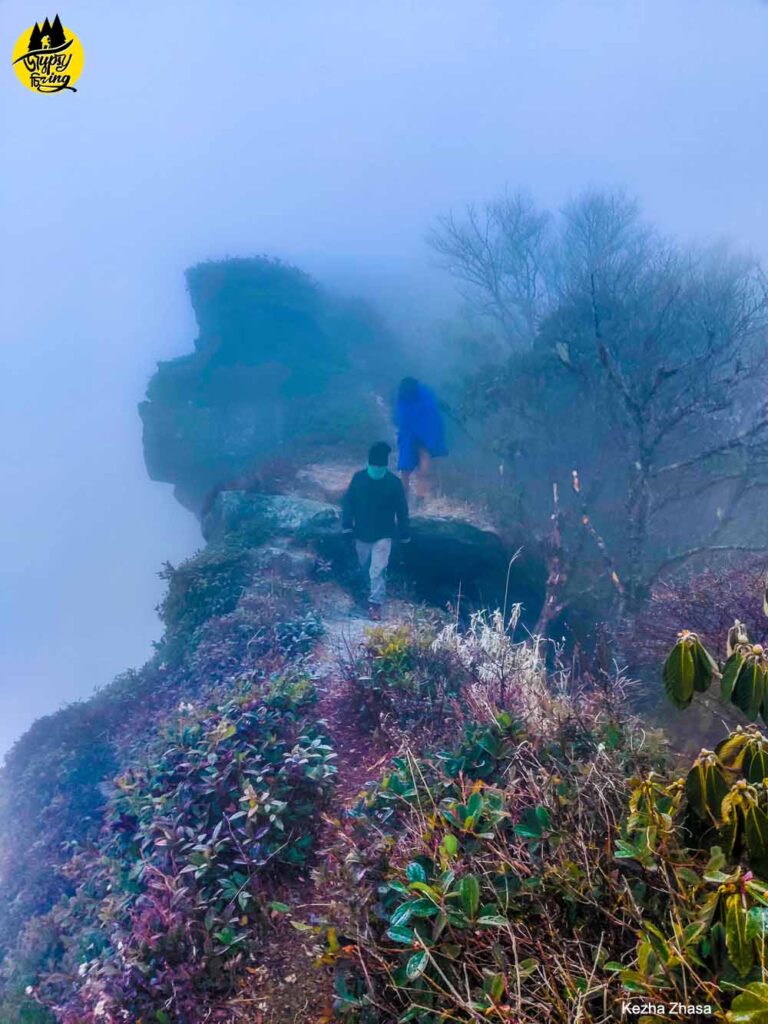
There were larger and safer places to take refuge from the wind. Alas! We chose the first stop we got.
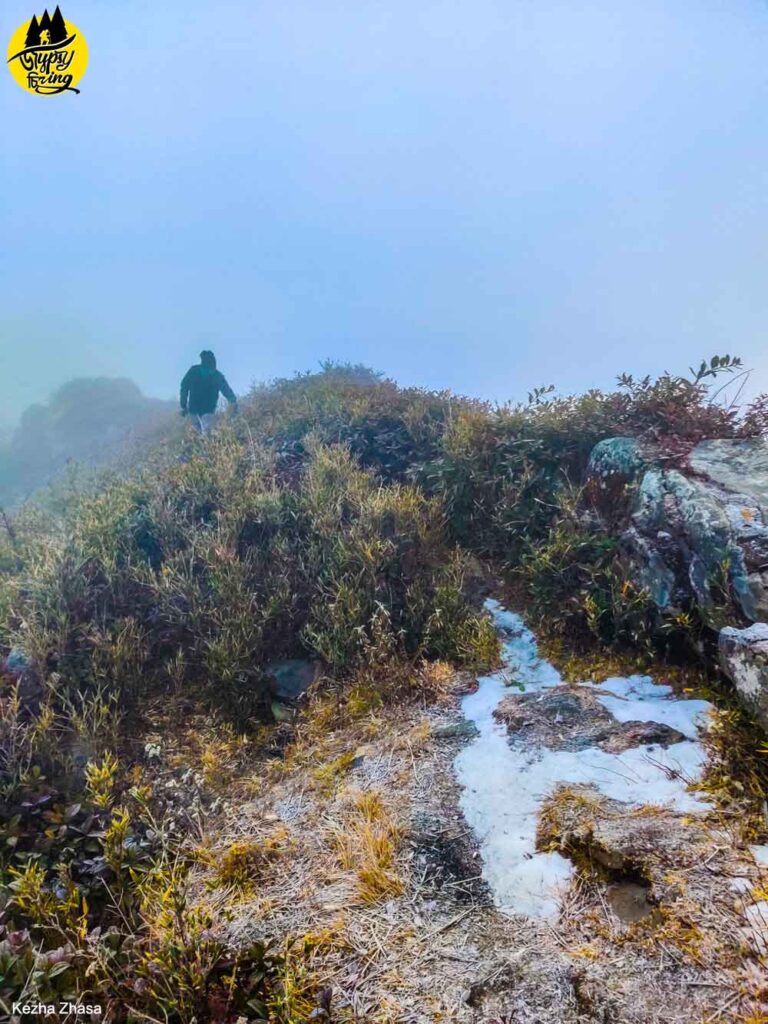
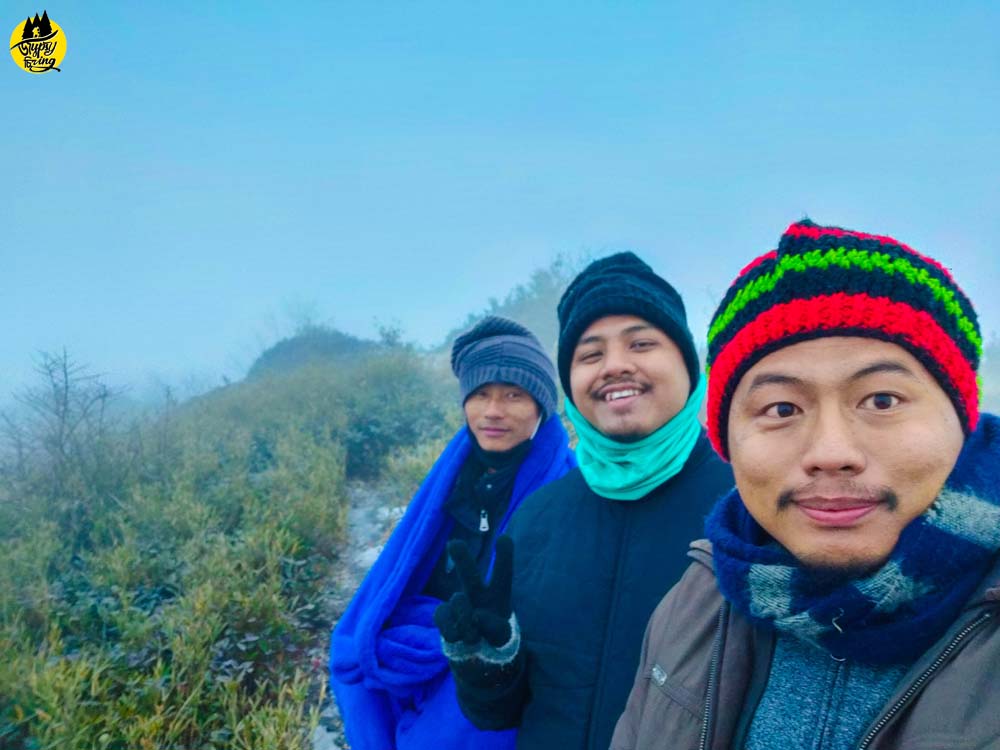
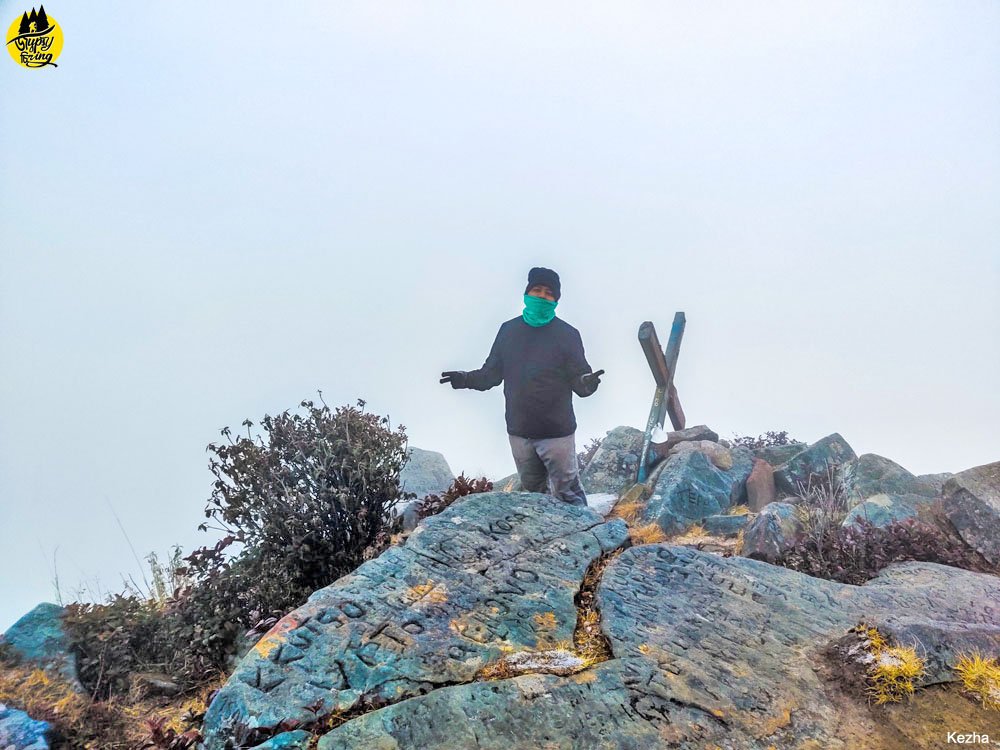
Trekking Back to the Base Camp & Kigwema
Descending the rock wall seemed easier than climbing it. Reaching the traversing part, our eyes lay on the ice patches. The entire slope was covered with snow.
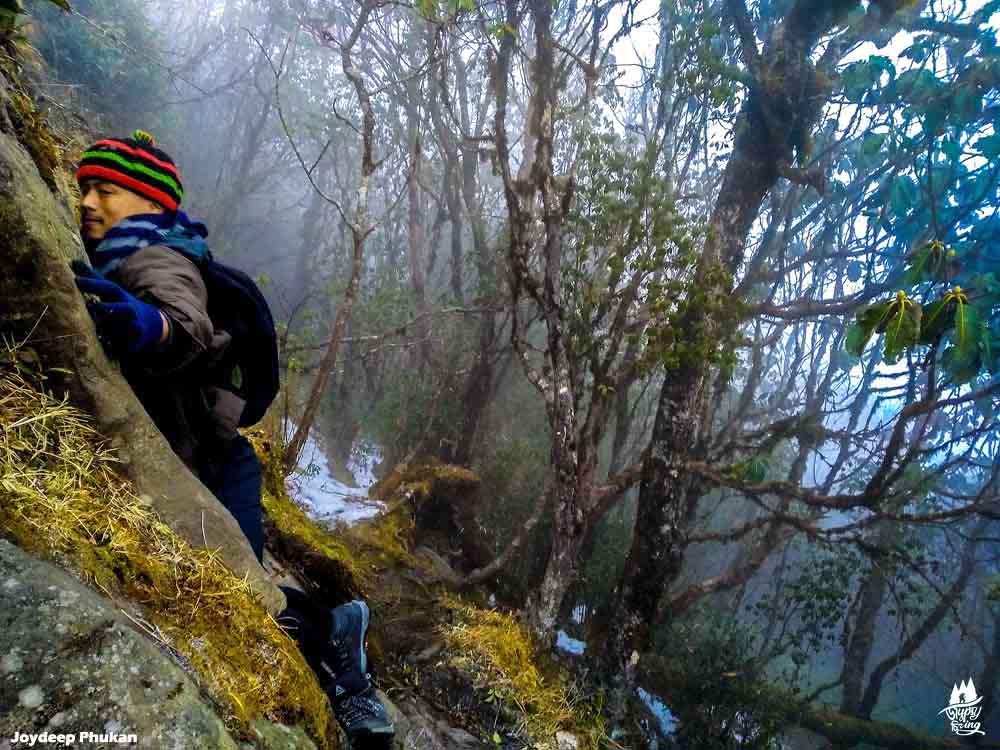
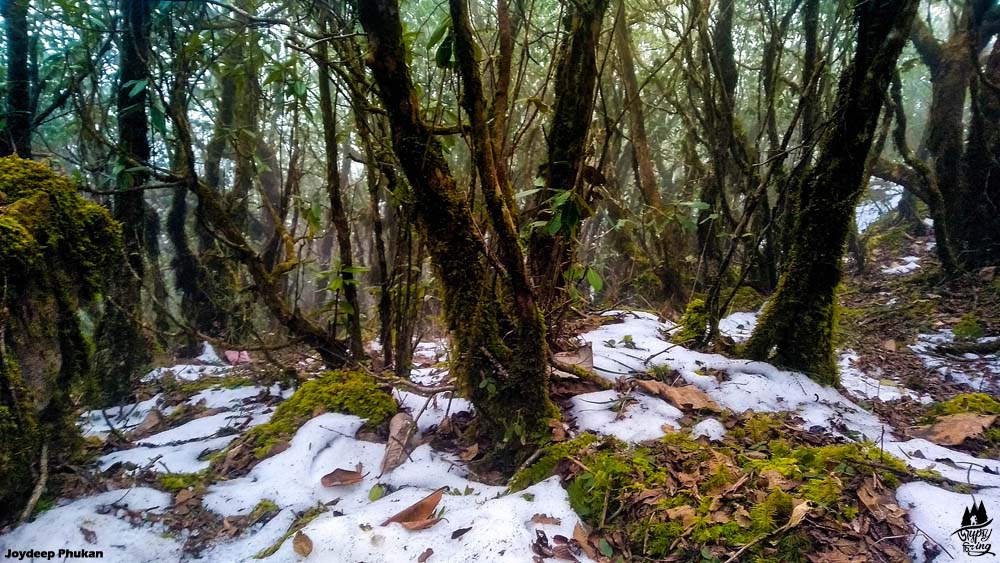
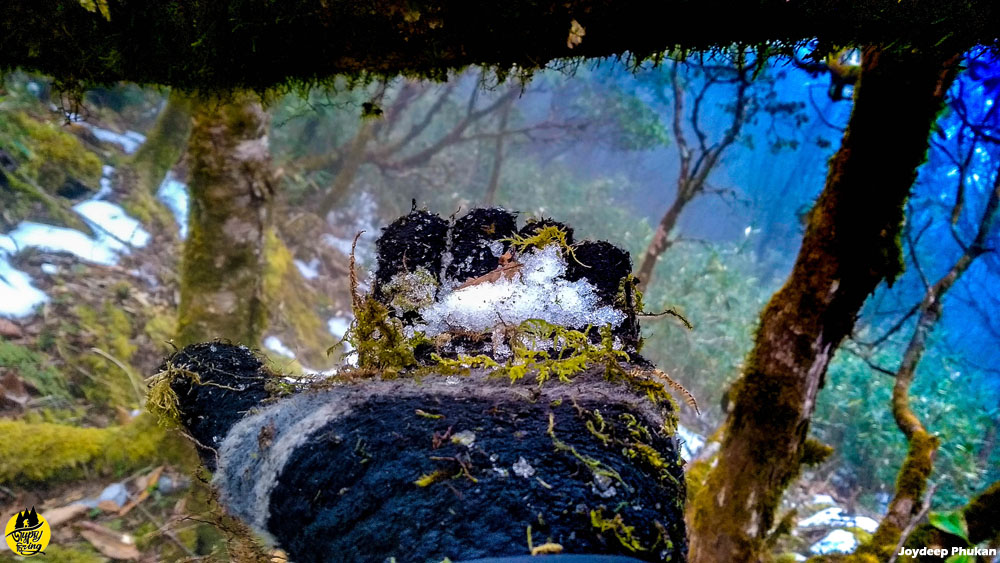
Touching the snow with bare hands to feel its sensation, was something my soul had yearned for a long time.
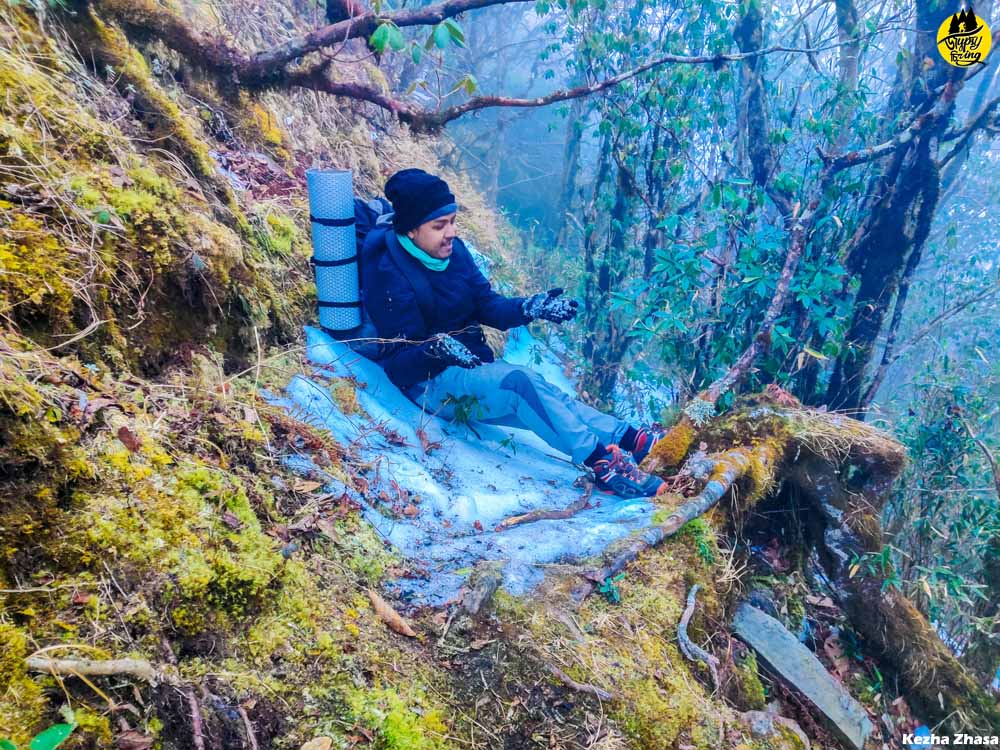
Kezha and I took our time, embracing every single moment of our descent slowly.
With every smaller peak we descended to, Mt. Japfu revealed itself with the best of its beauty.
The clouds playing hide and seek with the peak, the sun finally greeting us, and the blue skies with the view of the twin peak of Mt. Japfu comforted the mind.
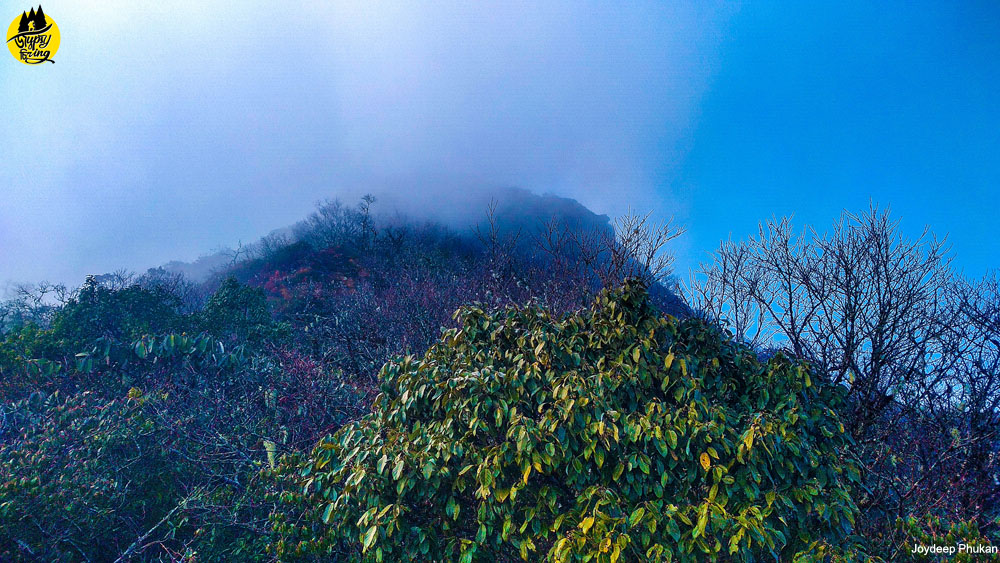
How lucky we were to have witnessed that! The clouds moved like it is being chased by someone.
The peak would be covered with fog in one second, and within a blink of an eye, it would be clear. The peak shined with the crown of blue sky.

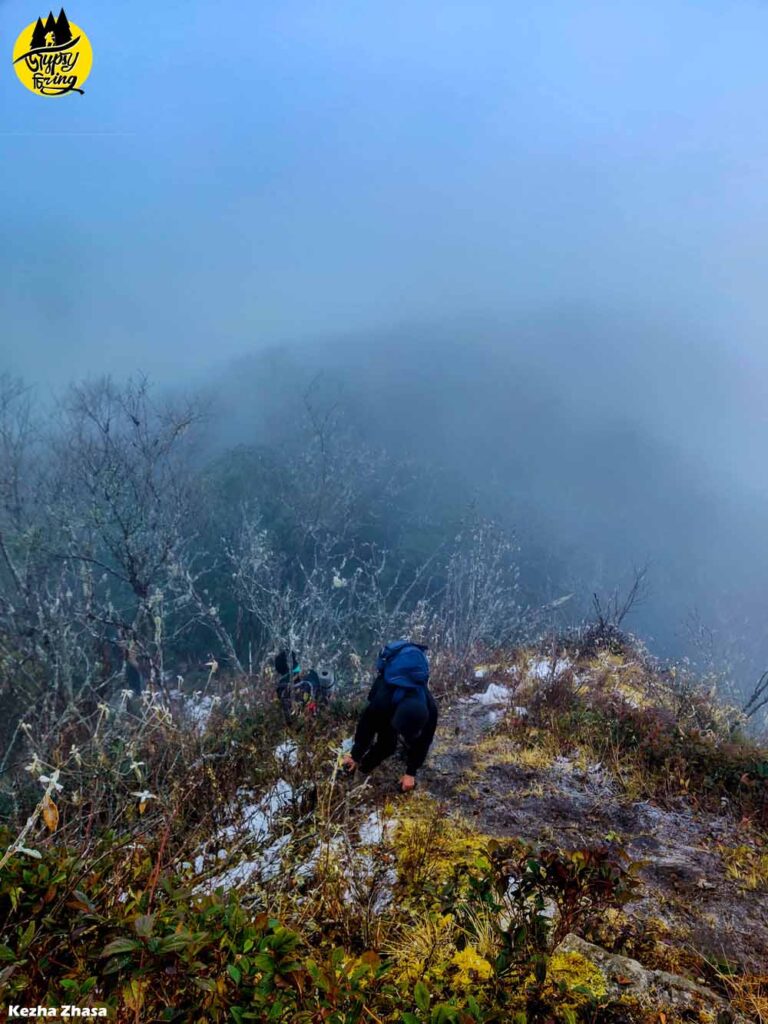
The scenery was more beautiful as we went further down.
Descending a smaller rock wall, there was this beautiful point where the edge ahead was full of snow, surrounded by trees- I stood.
The cityscapes of Kohima and Kigwema could be seen from there.


Every time we saw a structure in the trees, we would give an analogy to it.
It felt special to learn that we trekked the entire night unaware of its hidden beauty, to be witnessed the next day under sunlight.
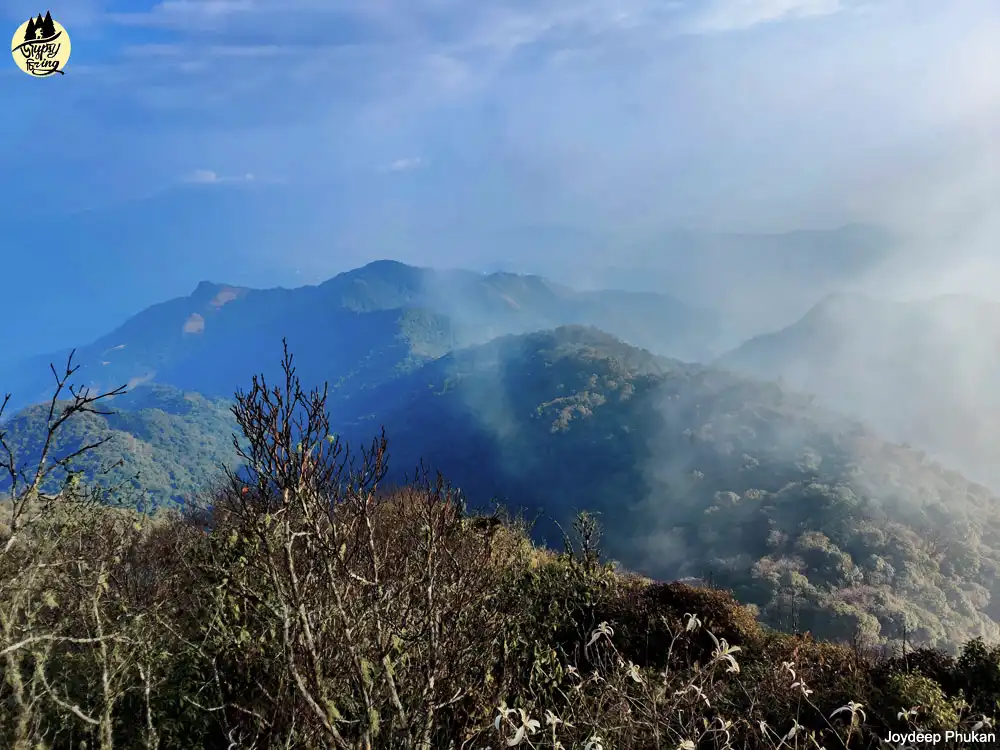
The best about the trail was the flora, the trees and its chain of branches. Treading through it by dodging the entangled branches was pleasing.


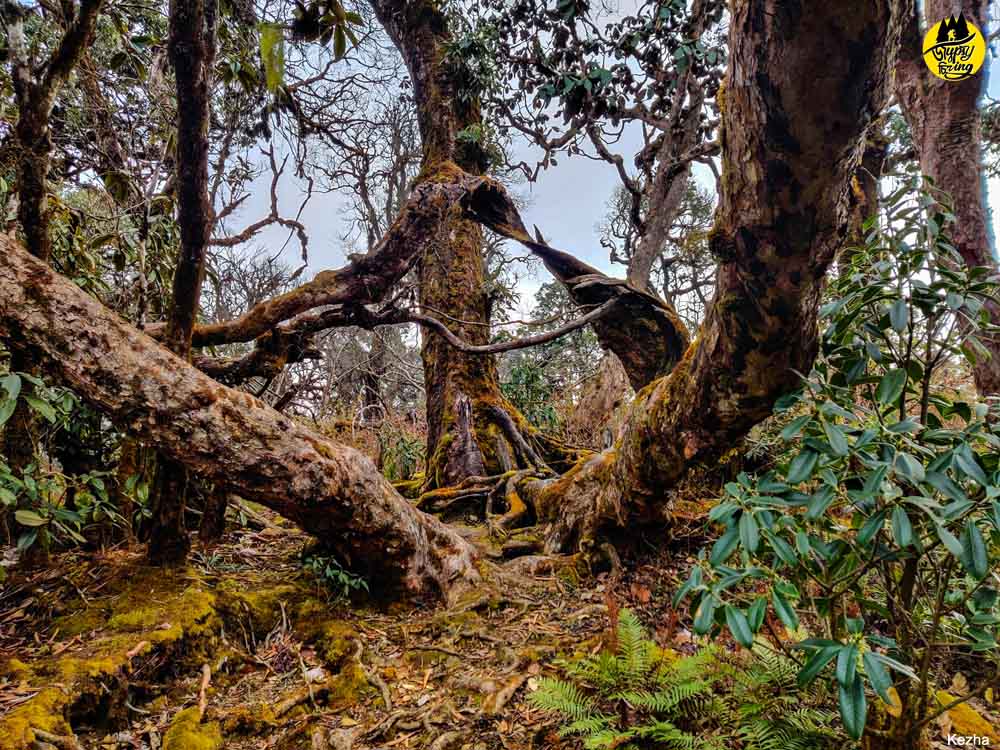
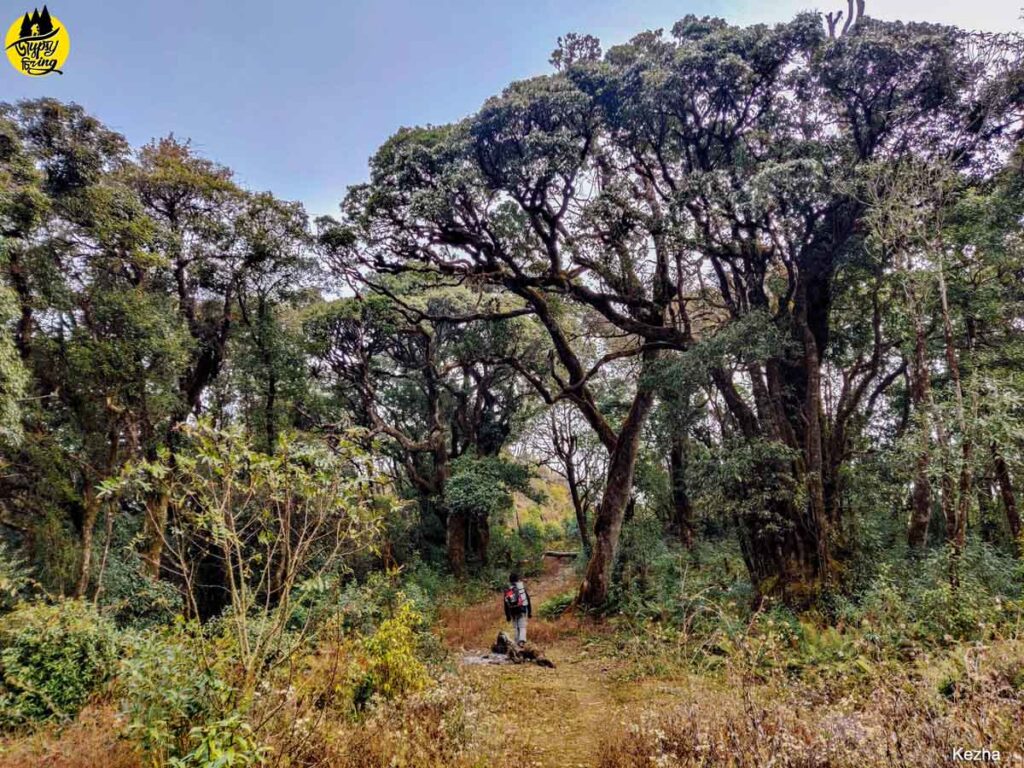

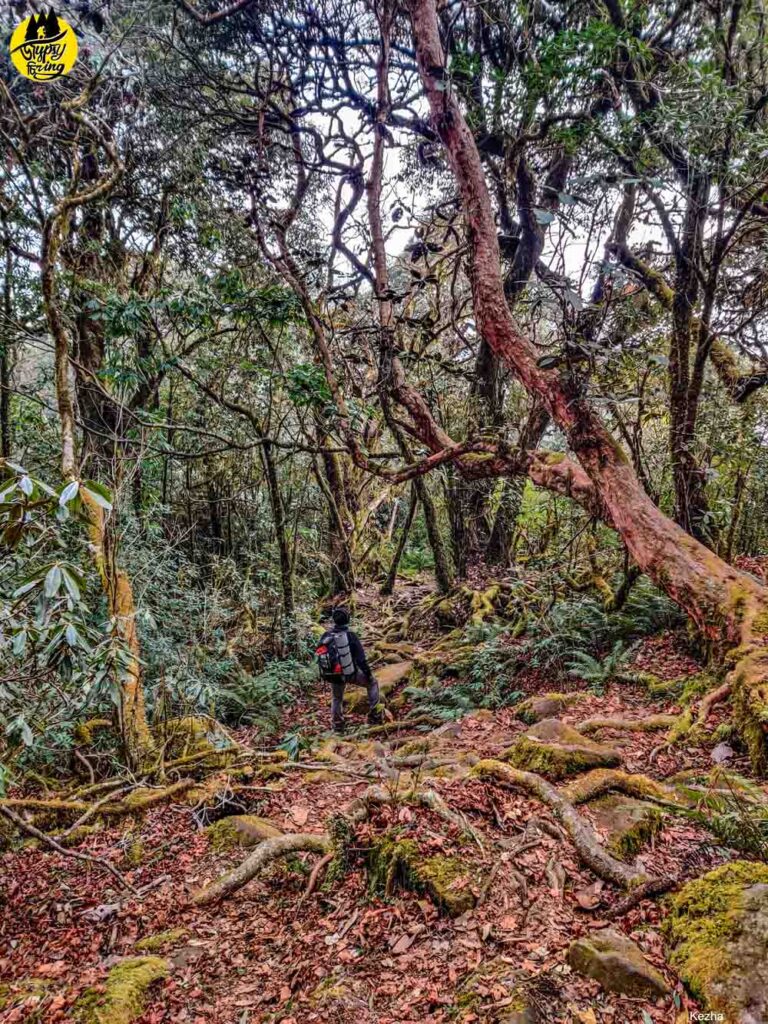
The clouds turned dark and the sky murky; it started drizzling eventually.
Before it could become as gutsy as the wind of the previous night, we ran towards the base camp. The rain subdued and therefore, the trek back to Kigwema began.
We reached the homestay at 2 pm.
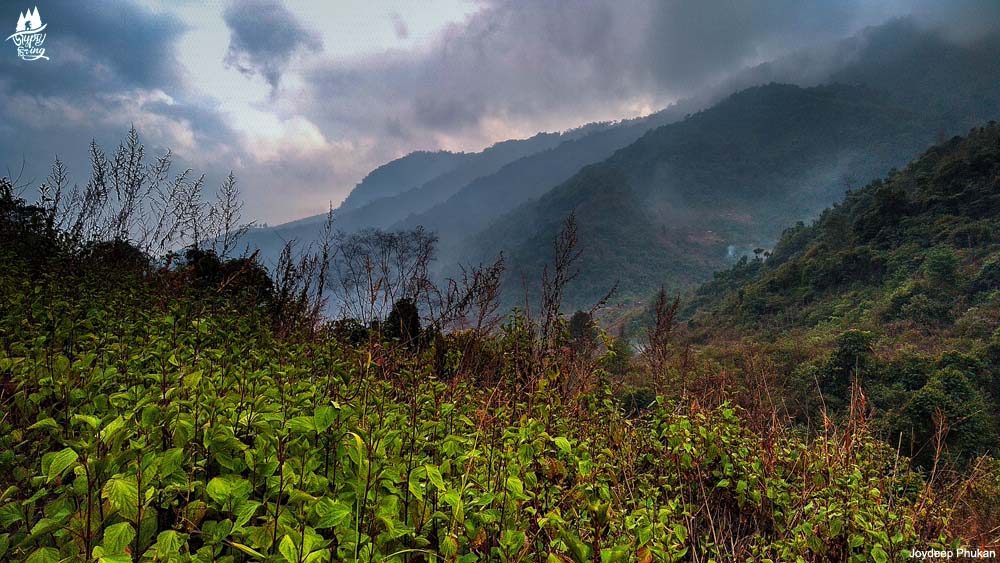
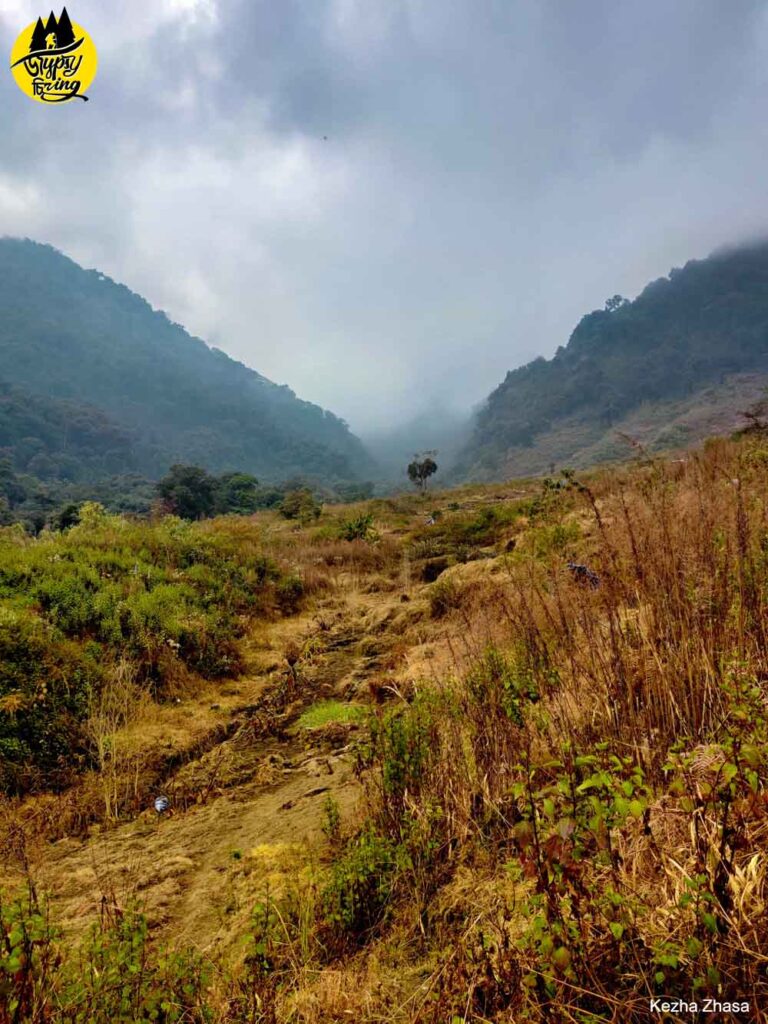
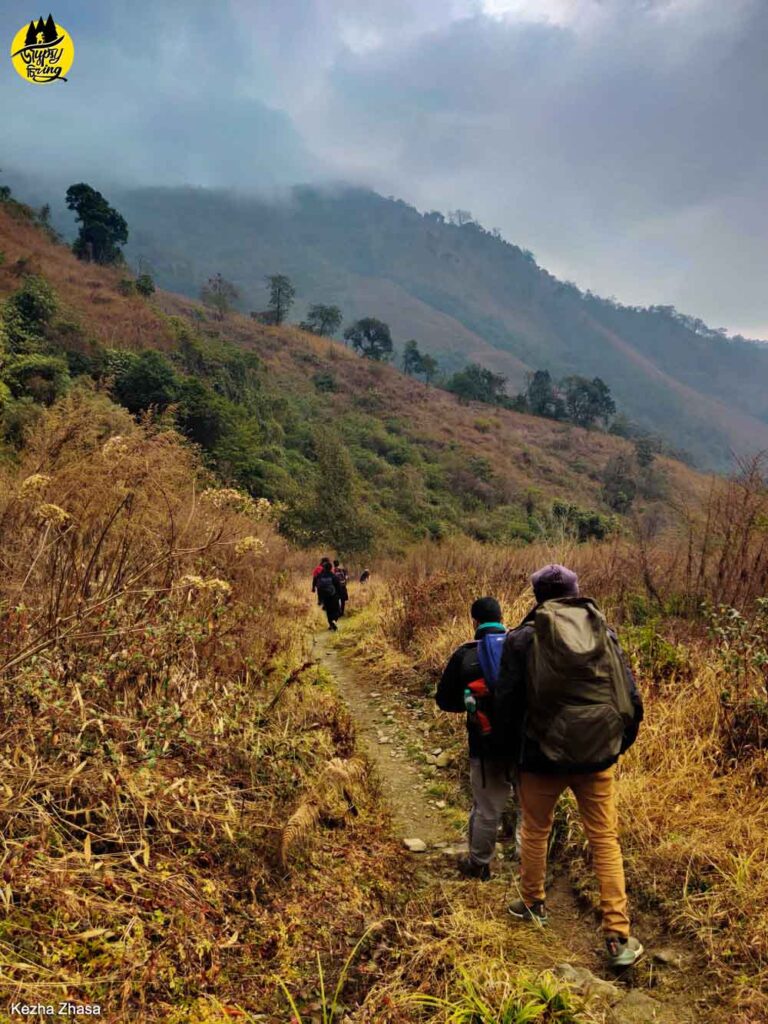
Day 4 – Jakhama Village Tour
While I rested for the day. The next morning, Kezha introduced me to the terrace fields of Jakhama and his ancestral Kigwema village.
A conversation with a French cyclist about Kohima and his next visit to Majuli, whom I had met mid-way to Dimapur concluded the trip.

Summing it Up
In a world of chaos, it is through travel that we build meaningful relationships with friends, nature, culture and unexplored places. Travel unifies souls, some say.
Well, it indeed has gifted me a friend with whom I share the same zeal and love for nature and adventure.
The trek to Mount Japfu has taught me the quintessence of friendship and culture.
Chanting Mepfü while trekking with them, made me feel like I was a part of their culture. Thank you, Nagaland!
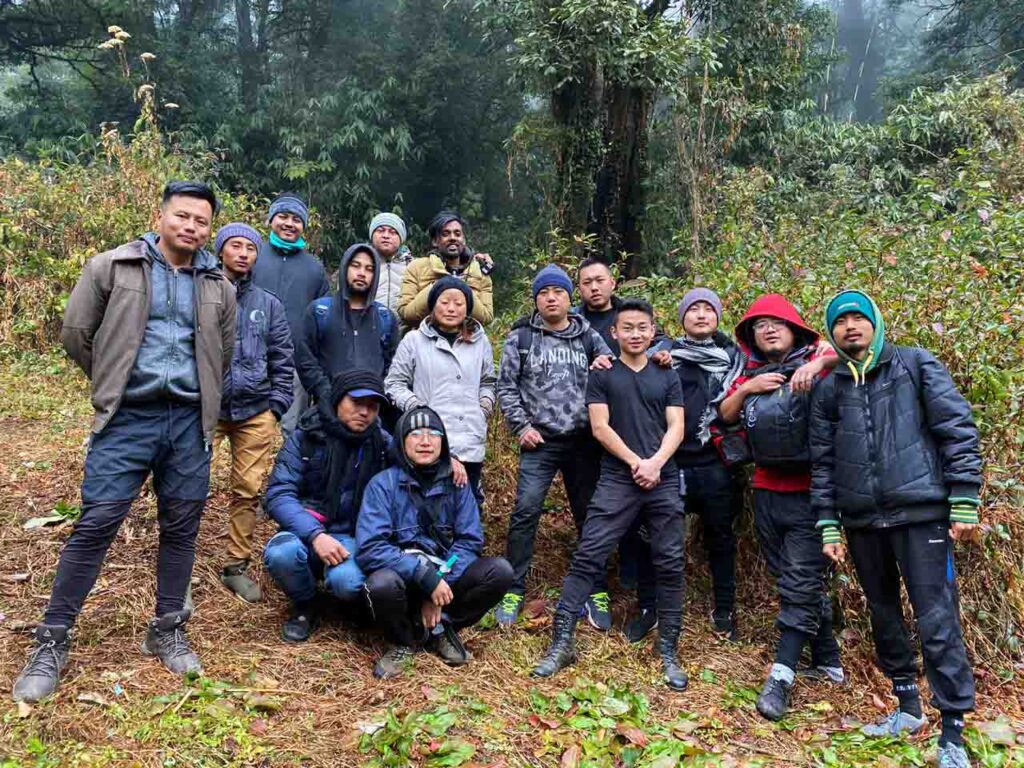
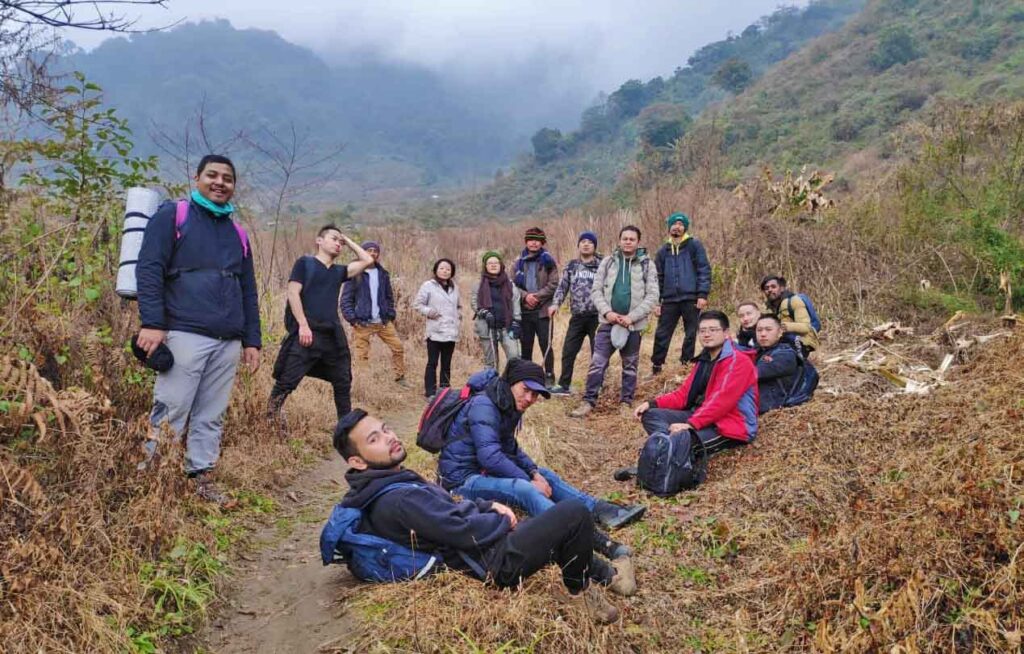
Mt. Japfu Peak Trek Guide – FAQ
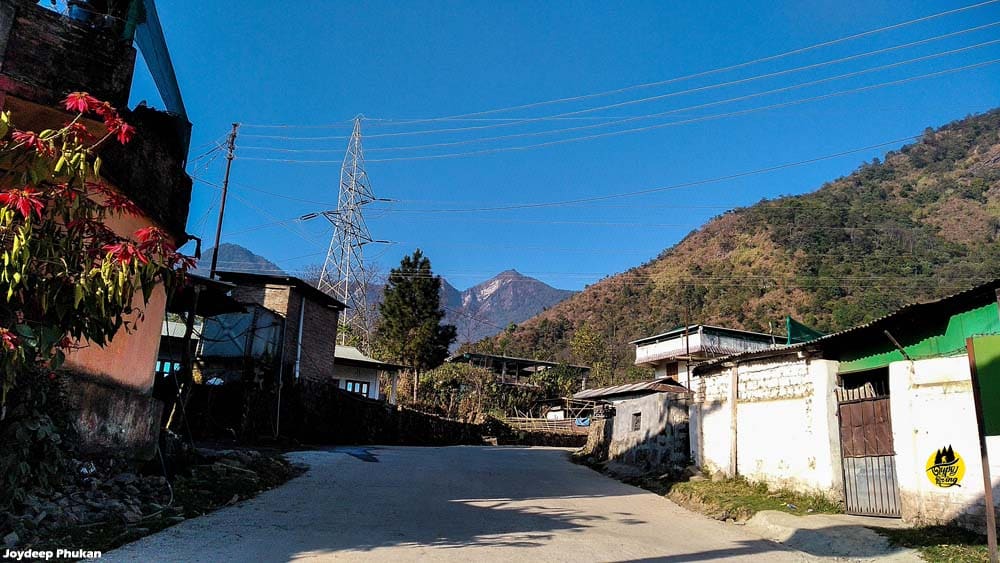
How to reach Japfu Peak?
The Mt. Japfu trek time is about 7 hours from Kigwema Village to the peak if not rested longer at the base camp.
How to reach Japfu Peak from Dimapur & Kohima?
1. Reach Dimapur via Train at Dimapur Railway Station or by flight at Dimapur airport or by Bus.
2. Book tickets for a Cab or Bus (Shared fare). Cars for hire are also available in Dimapur.
3. Reach Kohima and head to Kigwema by the end of the day.
4. Start the Mount Japfu trek at night and reach the base camp early.
Or stay in Kigwema for the night.
5. Start the trek to Japfu Peak at midnight and reach before sunrise.
Or start the trek the next morning.
How can I apply Inner Line Permit (ILP) for Nagaland?
For citizens of India outside Nagaland and foreigners, an Inner Line Permit (ILP) is a must. It can be issued via the following-
1. Online – Apply Here. I got my ILP within 24 hours.
2. Offline – Nagaland House Offices in Delhi, Kolkata, Guwahati and Shillong.
Hotels in Kohima & Kigwema – Accomodation
I stayed at Morung Lodge in Kohima and Greenwood Villa Homestay in Kigwema at a reasonable rate
Whom to Contact for Mount Japfu Trek?
For local guides, enquire at Greenwood Villa Homestay. Inform them beforehand.
What is the best time to visit Japfu Peak?
The best time to visit Japfu Peak is from September to April. For Snow – December to early February. For Rhododendron blooms of multiple colours visit from March to April.
Is it safe to trek Mt. Japfu in Summer (monsoon)?
The Japfu peak trek in Summer is full of rain; leeches dominate the trees and the trail. Therefore, I would not recommend doing the Mt. Japfu trek in Monsoon.
What is the Kohima to Japfu peak distance?
The distance from Kohima to Kigwema is 16.3 km. The actual trail starts from Kigwema via Japfu Christian College and Pony Farm trail in Kigwema.
7 Reasons Why you must do the Japfu Trek –
1. Mt. Japfu (pronounced as Japfii) is the 2nd highest peak of Nagaland after Mt. Saramati.
2. It is relatively less explored than Dzukou Valley.
3. The top of the peak is accompanied by two more twin peaks – meaning there’s a lot to explore at the peak too.
4. The world’s tallest Rhododendron with a height of 108ft and still growing since the time of its discovery in 1993, is located in the Mt. Japfu Range.
In which district is Mount Japfu located?
Mount Japfu is located in the Kohima district of Nagaland in Northeast India.
What is Japfu Peak’s height?
The Japfu height is 3048m above sea level.
Does it snow in Japfu Peak?
Yes, it snows every year at Japfu Peak, Nagaland. Refer to the following Instagram post –
Loved reading the article? Share it with your friends.

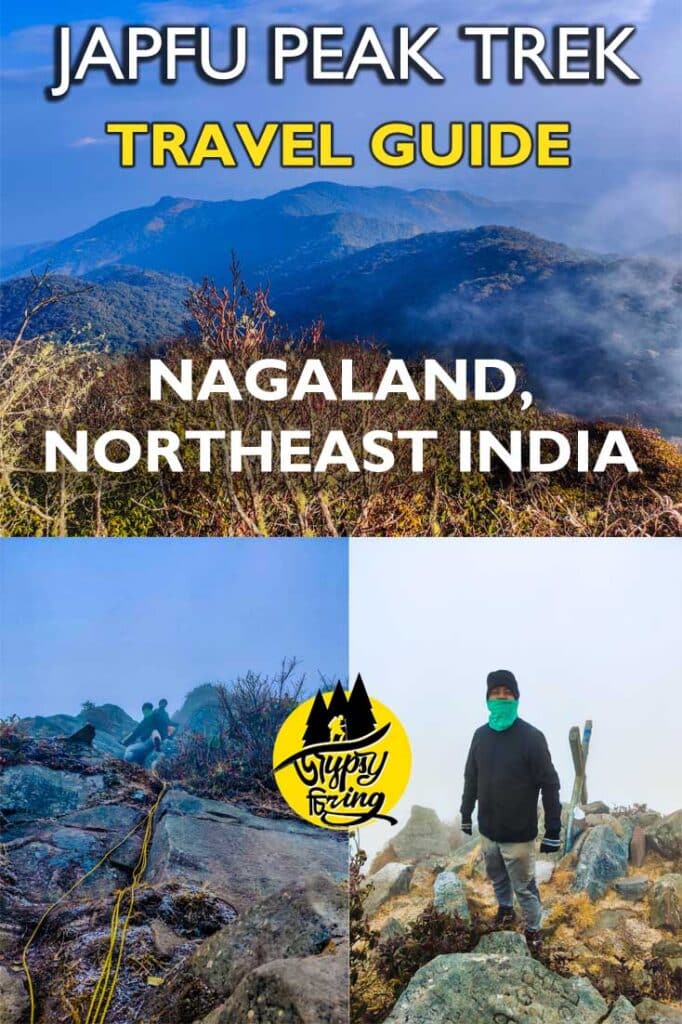
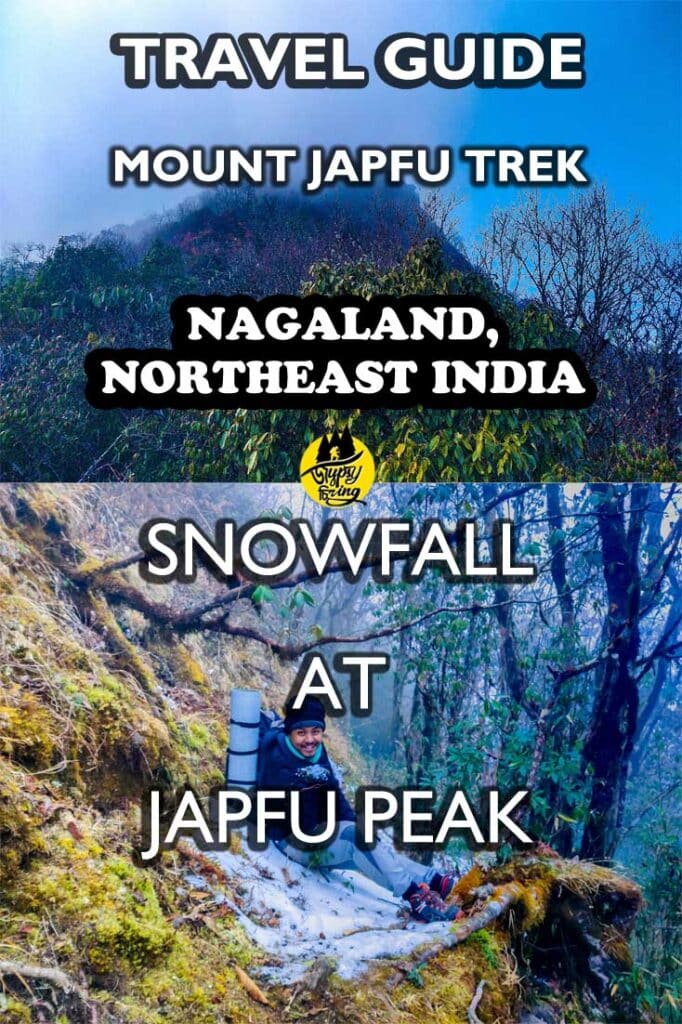
Many thanks, Joydeep, for your treks to the Nagaland Hills. I have visited Pfutsero a few times since December 2018. I am a retired English engineer, and have stayed several times at Central Guest House, Kohima, which was run by my late friend, Ato and his family.
I have trekked in The Annapurna region, several times , including another visit to Poon Hill, in December 20022, at the age of 77. Makes me feel like I want to put on my trekking boots and set off once more on the trail.
Keep up the good work, best wishes from Roamin’ Uncle Richard, in Bulgaria.
Hey Richard (Uncle),
I am delighted to know that you read the article and that you have visited Nagaland already.
Yeah, we had fun staying at Central Guest House during our first Dzukou Valley Trek in 2019. Sorry to hear Ato’s demise.
Pfutsero is beautiful, I visited it in December 2021, we further went to Kapamodzu Peak. I am currently working on the article. Do subscribe, I will update you once published.
Guess what?I went to Annapurna Base Camp trek last year in November. I met a lot of hikers aged above 60 too. You being a true adventurer, I would love to meet you and share stories about each other.
Let me know if you come to Northeast again. We will explore Arunachal Pradesh together next time.
Thanks a lot for the appreciation. Means a lot.
As always I could picture every detail you mentioned so beautifully in the blog. Also this covers all the info. Great going
Thanks Bijetri.
Hope to see you exploring Nagaland soon.
Wow! Very beautiful scenery of Nagaland. By reading, it feels like I have also visited this place with you. Each word that you have penned down is so real. Great work dada, Keep shining.
Thanks Dipanjali.
I am happy to hear that you could visually travel to Mount Japfu with each word. Thanks for the wishes.
The beauty of Nagaland is so mesmerizing! Beauty of Northeast ❤️
Indeed Kavya. Let’s visit Hornbill Festival in Nagaland this time.